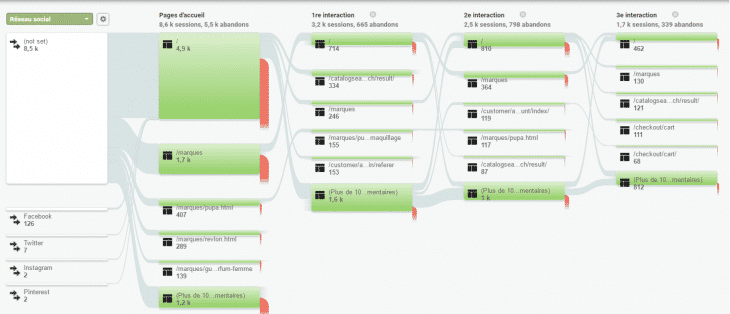Why is website analysis important?
Before diving into the details, it's important to understand why website analysis is essential. Website analytics play a fundamental role in understanding the overall health of your online presence. It goes far beyond simply tracking the number of visitors to your site. In fact, it offers you in-depth insight into how your site interacts with your visitors, and how you can improve their experience and generate more engagement with them.
Site performance evaluation
Website analysis enables you to evaluate the overall performance of your site. You can find out which pages are visited the most, how long visitors spend on your site on average, and what actions they take. This information helps you identify your site's strong points, as well as areas that could use improvement.
Identifying opportunities for improvement
One of the major reasons why website analysis is important is that it helps you identify opportunities for improvement. By examining your site's data, you can identify pages with a high bounce rate, i.e. pages where visitors leave your site after visiting just one page. This may indicate that the content on these pages is not sufficiently relevant or engaging. By understanding these weak points, you can make adjustments to retain more visitors.
Optimizing the user experience
User experience is at the heart of online success. Website analytics enables you to track user behavior, find out what actions they perform on your site and where they encounter obstacles. If you find that many visitors abandon their shopping baskets at a certain stage of the process, this may indicate a problem in the checkout process. By optimizing these friction points, you can improve the user experience and increase conversions.
Use of Google Analytics and other tools
For effective website analysis, you can use tools such as Google Analytics. Google Analytics provides a wealth of valuable data about your visitors, including their geographic location, browsing behavior, traffic sources, keywords that led to your site, and much more. This information can help you better understand who your visitors are and how they interact with your site.
Focus on key metrics
When conducting a website analysis, it's important to focus on the key metrics that correlate with your goals. Rather than getting lost in a lot of data, choose a few metrics that are directly related to what you want to achieve with your site. For example, if you want to increase sales, track conversion rates on specific sales pages. Each analysis should be granular and generate concrete actions to be implemented. Identifying weaknesses and opportunities is strategic and one of our areas of expertise.
Understanding user behavior
Website analytics allows you to track user behavior across your site. You can see which pages they visit first, which pages they spend the most time on, and which pages they leave quickly. This information helps you understand what attracts their attention and what might discourage them. Use this knowledge to optimize your site's content and navigation.

Basic steps in website analysis
Configuration of analysis tools
Find out how to set up tools like Google Analytics to collect valuable data about your site.
When it comes to analyzing a website, the first essential step is to set up reliable analysis tools, such as Google Analytics. Google Analytics is a powerful platform for collecting and analyzing in-depth data from your website. Here's how you can set up Google Analytics to start collecting relevant data.
Create a Google Analytics account
If you don't yet have a Google Analytics account, start by creating one. Use your existing Google Account or create a new one specifically for your website. Once you're logged in to your Google Account, access the Google Analytics platform and follow the instructions to create a new account. Want to get off to a good start? Contact us !
Adding a property
Once you've created an account, add a new property for your website. Each property corresponds to a specific website you wish to analyze. Follow the steps to add a new property and enter the required information, such as your site's URL.
Obtaining the tracking code
Once you've added a property, Google Analytics will provide you with a unique tracking code. This code must be integrated into the source code of each page of your website you wish to track. Place this code just before the closing tag of each page. This will enable Google Analytics to collect data on visitors and their behavior.
Lens configuration
In Google Analytics, you can define specific goals you want to achieve with your website, such as completing a form or reaching a confirmation page after a purchase. This feature enables you to track conversions and measure the success of your objectives.
Exploring reports
Once Google Analytics is collecting data, you can explore the various reports available. Analyze traffic data, traffic sources, user behavior, most visited pages and much more. Use filters and segments to obtain specific information that answers your questions.
By using Google Analytics and similar tools, you can obtain detailed data on your site's visitors, their behavior and their interactions. You can track metrics such as bounce rate, time spent on site, most viewed pages, conversions and much more. This data gives you valuable insights into the effectiveness of your website, and how you can optimize it to meet the needs of your target audience.
Traffic and source analysis
Learn how to interpret traffic data to understand where your visitors are coming from and which pages are the most popular.
Traffic and source analysis is an essential component of website analysis. It allows you to decipher your site's data to better understand where your visitors come from, and which parts of your site generate the most interest. This provides crucial information to guide your online optimization efforts.
Traffic analysis
Using tools like Google Analytics, you can get detailed information about your website's traffic. Explore reports that show you traffic sources, whether organic searches, direct traffic, referrals from other websites or traffic from social media. This data helps you understand which sources generate the most visitors and adjust your strategy accordingly.
Source analysis
Understanding which sources are driving traffic to your site is a crucial part of the analysis. For example, if you find that the majority of your traffic comes from search engines, this could indicate that your SEO strategy is effective. If direct traffic is high, it could mean that your brand is well recognized. If social media is a major source of traffic, it could be the result of marketing campaigns or viral content sharing.
The importance of website data
By examining traffic and source data, you gain valuable insight into the effectiveness of your marketing efforts and online presence. This data can also help you identify opportunities to improve certain traffic sources. For example, if organic searches are low, this could indicate the need to optimize your content for search engines. If social media isn't generating as much traffic as expected, you may want to consider adjusting your social media strategy.
Key metrics for traffic analysis
When analyzing traffic and sources, keep an eye on key metrics. Sessions" represent the total number of visits to your site. Users" indicate how many unique visitors have accessed your site. Bounce rate" shows the proportion of visitors who left your site after viewing a single page. These metrics help you assess your site's engagement and appeal to visitors.
Evaluating user behavior
Explore how to track your users' behavior on your site, including pages visited, time spent and actions taken.
It allows you to dive deeper into your site's data to understand how visitors interact with your content and what their journeys are. This deeper understanding helps you make informed decisions to optimize the user experience and maximize your online optimization efforts.
Tracking visited pages
With tools like Google Analytics, you can track the specific pages users visit on your site. This information helps you identify the most popular pages, as well as those that attract the least attention. For example, if you have a blog with several articles, you can find out which articles are the most consulted. This can guide you in creating similar content in the future.
Time analysis
An important metric for assessing user engagement is time spent on your site. If visitors spend little time on your pages, this may indicate a lack of interest or relevance. On the other hand, if time spent is high on certain pages, this may suggest that your content is informative and engaging. Use this information to adjust your content strategy accordingly.
Actions taken
Understanding the actions taken by users is essential to improving their experience. For example, track clicks on call-to-action buttons, forms completed, downloads performed, or products added to the shopping cart. If you find that many visitors leave the page after completing a form, this could indicate a complication in the process. By adjusting interactive elements according to this data, you can increase conversions and improve the user experience.
Using Key Metrics
When evaluating user behavior, keep key metrics in mind. Page views" tell you how many pages have been consulted in total. Bounce rate" measures the proportion of visitors who leave your site after viewing a single page. The "conversion rate" reveals the percentage of visitors who have carried out a desired action, such as signing up for a newsletter or purchasing a product. These metrics help you understand your site's effectiveness and identify areas for improvement.
Online optimization with Google Analytics
Google Analytics offers advanced features for tracking user behavior. You can create "goals" to measure conversions, define "events" to track specific actions, and set up "conversion funnels" to track users' journeys through your site. Combine these features with data on pages visited and time spent, and you get a complete view of your users' behavior.

Page performance analysis
Find out how to evaluate the performance of your pages, including bounce rates, conversion rates and more.
Bounce rate
Bounce rate is a key metric that indicates the percentage of visitors who leave your site after viewing a single page. A high bounce rate can be a sign that page content is not meeting visitors' expectations. Online optimization involves reducing this rate by making content more engaging and relevant. For example, by using catchy headlines, attractive images and ensuring that content is easy to read, you can encourage visitors to explore your site further.
Conversion rates
The conversion rate measures the percentage of visitors who complete a specific action you've defined as a goal, such as purchasing a product, submitting a form or signing up for a newsletter. To improve this rate, it's important to understand the friction points that might be preventing visitors from completing these actions. You can use tools like Google Analytics to track users' journeys through your site, identify the stages where conversions are lost, and make adjustments to ease the process.
Analysis of popular pages
Page performance analysis also includes identifying the most popular pages. These pages attract the highest number of visitors and can provide valuable information about the preferences of your target audience. For example, if you find that your blog posts on a specific topic generate a lot of traffic, this could indicate a high level of interest in that topic. You can use this information to create more similar content to keep your visitors' attention.
Content optimization
One of the keys to improving page performance is content optimization. This means creating high-quality, relevant content that meets the needs and interests of your visitors. Use relevant keywords related to your field to improve your pages' search engine ranking. And make sure you structure your articles with clear headings, subheadings and paragraphs for easy reading.
Use of key metrics
When evaluating page performance, keep in mind the key metrics related to your objective. For example, if you're looking to increase sales, focus on conversion rates on product pages. If you want to boost engagement, monitor time spent on pages and the number of shares on social media. These metrics guide you to the areas that need your attention and optimization efforts.
Tips for beginners
Define your goals
Identify your key objectives for website analytics, whether to increase sales, improve engagement or strengthen your online presence.
When you embark on website analysis, it's essential to clearly define your objectives. These goals will serve as a compass to guide your online optimization efforts. Whether you're looking to increase sales, improve user engagement or strengthen your online presence, having clearly defined objectives will enable you to measure your progress and make informed decisions.
The importance of defining objectives lies in the fact that it helps you focus your efforts on what matters most to your business or website. If your main objective is to increase sales, for example, you could focus on metrics such as conversion rate and sales generated by the site. If your priority is to improve engagement, you could track metrics such as time spent on the site, page views per session and bounce rate.
When defining your objectives, make sure they are specific, measurable, achievable, relevant and time-bound (SMART criteria). For example, instead of simply wanting to "increase sales", define a concrete objective such as "increase sales of product X by 15% by the end of the quarter". This gives you a precise target to hit, and makes it easier to measure your success.
Once you have clear objectives in mind, you can align your website analytics efforts to support them. For example, if your goal is to increase sales, you might closely monitor product pages, conversion rates on those pages, and user behavior in the buying process. If your goal is to strengthen your online presence, you could focus on visibility-related metrics, such as search result rankings and organic traffic growth.
Using tools such as Google Analytics, you can set up specific goals to track actions you consider successful. For example, if you want users to fill in a contact form, you can define this event as a goal in Google Analytics. This will enable you to track the conversion rate for this objective and adjust your strategy accordingly.
Call on one of our business mentors specialized in your business sector. He'll work with you to analyze your objectives and guide you through all the data you need to track and the growth plan you absolutely must put in place to achieve them.

Focus on key metrics
Focus on a few key metrics that are aligned with your objectives, rather than being overwhelmed by complex data.
When embarking on website analytics, it's crucial to bear in mind that not all data is equal in terms of importance. Rather than being overwhelmed by a multitude of complex data, focus on a few key metrics that are directly aligned with your objectives. By doing so, you can gain relevant, actionable insights to improve your online strategy. Here's how you can perform targeted analysis using website data, including tools such as Google Analytics.
Bounce rate and time spent on site
These two metrics are essential for assessing the appeal and relevance of your content. A high bounce rate may indicate that visitors are leaving your site quickly, which may be due to unengaging content or a poor user experience. Similarly, time spent on site can give you an insight into the quality of your content. If visitors spend little time on your pages, it may mean that your content isn't meeting their expectations. By analyzing these metrics, you can identify which pages need improvement and make adjustments to retain more visitors.
Conversion rates
The conversion rate is a key measure of your website's effectiveness in achieving your objectives. These can include objectives such as sales, newsletter sign-ups, content downloads, etc. By tracking the conversion rate on specific pages, you can determine which parts of your site are working well and which may need improvement. If a conversion rate is below your expectations, this may indicate obstacles in the conversion process, such as an overly complex form or a poorly placed call-to-action button.
Traffic sources and keywords
Understanding where your visitors are coming from is crucial to fine-tuning your online marketing strategy. Use Google Analytics to track traffic sources, whether organic search, direct traffic, referrals or social media. In addition, explore the keywords that drove visitors to your site. This gives you an insight into the topics that interest your target audience. If you find that certain keywords generate a lot of traffic, you can create more content around them to attract more visitors.
User behavior
Tracking user behavior across your site is key to improving the user experience. Analyze the pages they visit first, the paths they take through your site and the actions they take. This helps you understand what interests them and where they encounter obstacles. For example, if you find that many visitors abandon their shopping baskets at a certain stage, this may indicate a problem in the purchasing process. By adjusting these friction points, you can increase conversions.
By focusing on these key metrics, you can avoid getting lost in a huge amount of data, and gain actionable insights for optimizing your website. However, bear in mind that website analysis is an iterative process. It's important to monitor these metrics regularly, testing different strategies and adjusting your approach according to the results. By using tools such as Google Analytics and staying focused on your objectives, you can gradually improve your site's performance, attract more visitors and achieve concrete results online.
Understand your audience
Use analytics to better understand your target audience, their preferences and behaviors on your site.
One of the main reasons why website analytics is so valuable is that it enables you to better understand your target audience. Data collected through tools like Google Analytics gives you in-depth insight into the preferences, behaviors and habits of your visitors on your site. Using this information, you can adjust your online strategy to meet your audience's needs and improve their experience on your site.
Online optimization based on user behavior
Online optimization relies heavily on understanding user behavior. Thanks to the data provided by website analytics, you can track the paths visitors take on your site, which pages they visit first, where they spend the most time, and which they leave quickly. This information helps you understand what attracts their attention and what might discourage them.
Imagine that the data shows that many visitors leave your site after viewing a specific page. If you look closely at this page, you may discover that the content isn't engaging enough, or that the call-to-action isn't convincing enough. By adjusting these elements according to the data, you can increase the conversion rate and improve the user experience.
The importance of key metrics for understanding behavior
Key metrics play a crucial role in understanding your users' behavior. Bounce rate" indicates whether visitors leave your site quickly, which can signal a lack of interest or relevance. Time spent on site" reveals visitors' engagement with your content. The "conversion rate" shows whether your objectives are being met, whether it's a purchase, registration or download.
By analyzing these key metrics in relation to each other, you get a complete picture of your users' behavior. For example, if you see a high bounce rate on a specific page, but the time spent on that page is also high, this could indicate that the content is interesting but lacks a call to action. By adjusting these elements, you can encourage visitors to continue interacting with your site.
Using Google Analytics to understand preferences
Google Analytics offers advanced features for understanding your audience's preferences. You can explore reports on the most popular pages, navigation paths, traffic sources and keywords that led to your site. By examining this data, you can discover which topics generate the most interest, which sources generate the most traffic, and how visitors interact with your content.
For example, if you run an e-commerce site and notice that certain product categories generate more traffic than others, this could indicate a clear preference on the part of your audience. You could then decide to highlight these categories in your marketing campaigns to attract more interested visitors.
Test and adjust
Experiment with different strategies based on your analyses, then monitor the results and adjust your approach accordingly.
Once you've collected meaningful data from website analytics and identified the key metrics that reflect user behavior and your site's effectiveness, it's time to move on to the next stage: experimentation and fine-tuning. This step is crucial to evolving your online strategy and maximizing the results you achieve.
Experimentation based on website data
Experimentation means testing different approaches and strategies to see what works best based on the data you've collected. With tools like Google Analytics, you can set up A/B tests or various tests to evaluate the impact of different changes on your site. Here's how to do it:
Identify areas for testing
Based on the key metrics you've analyzed, determine which areas of your site require adjustment. Perhaps you want to improve the conversion rate on a specific page, reduce the bounce rate on another, or increase the time spent on a particular category of content.
Formulate hypotheses
Before you start testing, formulate hypotheses about what you expect to improve. For example, if you notice a high bounce rate on a product page, your hypothesis might be that adding visual elements and a more detailed description will help retain visitors.
Create variants
Create different versions of the elements you want to test. This could include different titles, alternative layouts, modified calls to action, etc. Make sure your changes are based on concrete data and information.
Set up tests
Use testing tools like Google Optimize to set up your A/B or multivariate tests. Divide your visitors into control and test groups, then present them with the different variants. Let the accumulated data show you which version generates the desired results.
Adjustment based on results
Once you've obtained significant results from your tests, it's time to adjust your approach accordingly. Here's how:
Analyze the results
Examine the data collected during testing to see which variants had the best impact on the metrics you're tracking. Identify the changes that led to a noticeable improvement.
Apply best practices
Use the results to implement changes that have shown a significant improvement. For example, if a variation of your product page resulted in a higher conversion rate, apply these changes to the original version of the page.
Keep iterating
Online optimization is an ongoing process. Keep testing and adjusting different elements of your site to constantly seek better performance. Don't be afraid to experiment and try out new ideas to see how they affect results.
Be patient
Test results may not be immediate. It's important to give tests enough time to gather meaningful data, and not to jump to conclusions.
Conclusion
Website analysis for beginners can seem daunting at first, but with the simple tips in this article, you're well on your way to becoming an expert in data interpretation. By making intelligent use of the information you gather, you can improve your website's performance, attract more visitors and achieve your online goals.
If you want to turn your website analysis into a powerful weapon for your business, you need to set up a solid foundation and analyze it in depth to continually improve your website.
Our strategic and technical experts can help you achieve your short- and long-term objectives: contact them!

